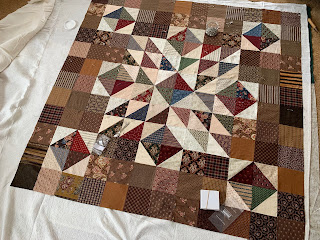This cabinet and the Singer 201-2 machine inside were a birthday present to myself in 2017. On February 12th, for $63, I picked up this present at an estate sale about a mile away from home. T came with me at the end of the sale to help carry the cabinet and machine out to the car.
 |
| Cabinet on the way to the car |
 |
| Veneer was faded from sun and worn around the edges where a mat had sat on the top |
This is the Singer Art Deco cabinet #42. It was made for 15-90's, 15-91's, 201-2's, and 301-1's.
 |
| Set up at home to see if the machine works |
I used the machine and cabinet for a couple years before I had time and the perfect weather to tackle the refinishing project outside. A couple weeks ago, T helped me carry the cabinet out to the patio then Dad took off the hardware and we sanded down the entire cabinet and stool.
 |
| Removing hinges and extensions |
Using two palm sanders and a few sheets of sand paper, we got off most of the darker stain on the drawer pulls and the trim around the bottom two inches of the table and the stool.
 |
| Table and bench got sanded |
 |
| All sanded |
This table had been sitting in a back sunroom at its previous house. Even after it was sanded, you could see a line in the wood from years of sunlight exposure.
 |
| Sun exposure line didn't sand out |
Originally, I had planned to keep the light wood color and just use a clear coat of polyurethane. A couple people pointed out though that most of the wood in my house, both in trim and furniture, is not this light. At the hardware store, I ended up picking out a red mahogany stain.
 |
| Red mahogany stain |
All the staining and drying was done on the back patio and then the pieces stayed in the garage between applications. The stain did not not cover evenly on all pieces, but I am glad that I went with the darker color.
 |
| Each piece gets stained |
After the polyurethane dried, all the pieces were brought back into the house and the table was reassembled. Things went together quickly, but I was left with two metal pieces and a spring when I was done. Had to study a pic of the cabinet online to figure out where those extra pieces went. The picture also showed me that I only had three of the four pieces I needed. Fortunately, I had seen the missing second spring when I was power-washing the patio a couple days earlier. Not knowing what it belonged to at the time, I had set it aside in a flower planter and was able to retrieve it quickly when I identified its intended placement. All four pieces fit under the back left hinge to support the extension when it was closed.
 |
| Reassembled |
 |
| The stool cushion will need to be changed soon |
 |
| Back of desk, sun line is less noticeable |
The 201 machine in the cabinet went with me to Ray's in the summer of 2017 and got a complete cleaning and rewiring so it should be good to sew for quite awhile. This machine has been my preferred buttonholer for the last couple years.
 |
| Ready to sew |













































